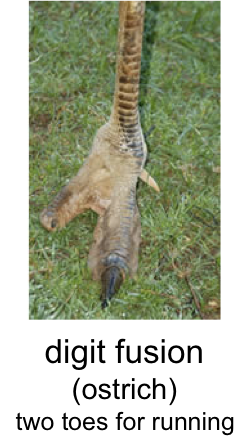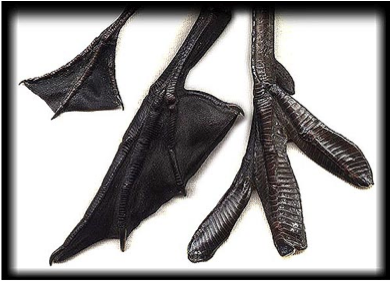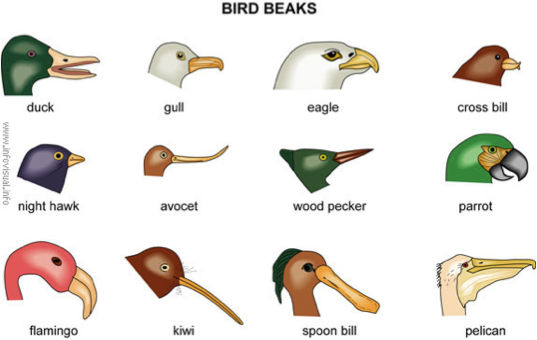Cards In This Set
| Front | Back |
|
What are conserved features?
|
a)feathers
b)oviparous
c)endothermic
d)flight
(not ratites, penguins, island birds)
e)bipedal
(with wings)
f)beak
g)small
size (no more than 150 kg)
|
|
What are the Variable attributes?
|
a)feather
morphology
b)nesting
habits
c)environment
selection
d, e) locomotory
speed/lift
f) foraging mode
g) body size (2 g –
150 g)
|
|
What are the functions of feathers?
|
-tracts
of dead keratinized tissue
(homologous with lepidosaur scales)
-
all have calamus, rachis, and vane
(containing barbs and barbules)
-
flight and tail feathers long and asymmetric
(optimize for displacing air)
-
downy feathers plumbaceous (insulation)
-
many brilliantly colored regions, often in males,
used in mate attraction or rival
deterrence
|
|
Other Flight adaptations of the avian body are...
|
(a)lightened: hollow bone,
feathers, no bladder, 1 ovary
- except diving ducks (need to sink)
(b)large flight muscles:
pectoralis major & supracoracoideus
- can account for 30-60% of all body muscle!
- leg muscles enlarged in predatory
raptors
(c)superior respiratory
performance: large
heart, high BP, air sacs
(d)protractable streamlined skeleton (e)myoglobin (oxygen-binding protein) enrichment in aerobic muscles - “dark meat” of chicken/turkey (f)wings are airfoils and propellers (can change angle of attack) - area varies according to mass of bird (wing loading) - pectoralis major powers downstroke; supracoracoideus powers upstroke |
|
What are some locomotory adaptations (for terrestrial)
|
 Hindlimbs!! |
|
What are some locomotory adaptations for aquatic/marine?
|
 Webbed/lobed feet (ducks)*paddling |
|
Beak length/width can predict food type:Insect =vertebrate =plankton =seeds =hole-probing =
|
- insect = short/thin
(warblers)
- vertebrate = heavy,
hooked (hawks/gulls)
- plankton = long,
filtering (duck, flamingo)
- seeds = short,
stout, even curved (finches, parrots)
- hole-probing =
long/thin (reach; hummingbirds)
stout (drilling)
(woodpeckers)
tongues
acquires/manipulates food too
|
 Which bird eats vertebrates? |
Gull (heavy, hooked)
|
|
Sensory perceptions of vision with birds...
|
-large
eyes, optic lobes, and midbrain
-
locate prey + avoid being eaten
-
see UV light (feather color + food)
|
|
Sensory perceptions of hearing with birds...
|
-
roughly equal to human range
-
large tympanic membrane to enhance sensitivity
-
esp. sensitive in owls (nocturnal hunters)
-
facial ruff is parabolic sound reflector
-
songbirds tuned to high frequency (song) as well
some tuned to low freq. too (approaching
thunder)
|
|
Sensory perceptions of olfaction with birds...
|
-
some with v. small olfactory
bulbs (poor smell)
-
water, ground, and hunting birds have larger bulbs
(find food or escape predation)
-
may play a role in navigation (homing)
-
tangerine scent of crested auklets is used in mating
|
|
Other sensory perception...
|
-
air pressure (flight, weather patterns)
-
magnetic fields (orientation; magnetite found in heads of pigeons)
|
|
Mating in birds..
|
(a)Rapid
act = “cloacal kiss”
(b)Much higher investment in mate competitions - colors and patterns - behavioral displays - song*these features also play a role in species recognition |
|
Breading system of birds...
|
-males
want multiple mates (sperm is cheap), females want one (help raising young)
- polygamy occurs in birds (more common in mammals): polygyny (polyandry rare) - social monogamy is most common though (90%; high parental investment by fathers) - pair bonds are typically annual; lifetime monogamy almost non-existent - extra-pair copulations (typically covert) also are frequent (0-60%) * males inseminate more mates * females get a better genetic mate * females get different/diverse genes |
|
Parental care of offsprings
|
-
eggs produced in clutches (1 every few years to 25 per bout, up to 3 bouts)
- nests can include classic cup nest, tree cavity, on rocks, in burrow * covered in megapodes, on feet of penguins* some colonially (gulls) - mothers (typically) incubate by sitting on eggs (exposing brood patch) - sex determined by genes, sex can be biased according to diet/mate - some young hatch mature (precocial), typically ancestral birds (ducks, gamebirds) * require little attention - others hatch naked and immature (altricial); a derived trait * require warmth, food, and predator protection - some stay with parents for days (10-12); others remain for years * cooperative breeding (kids help parents breed) |



